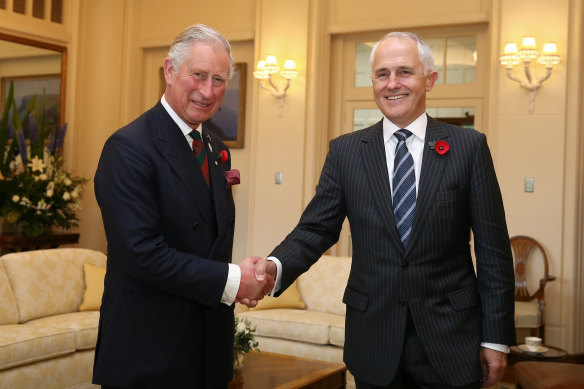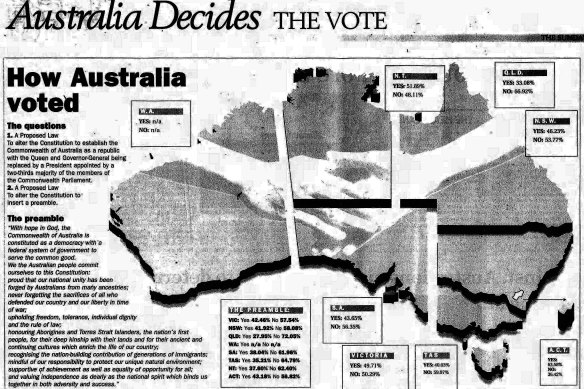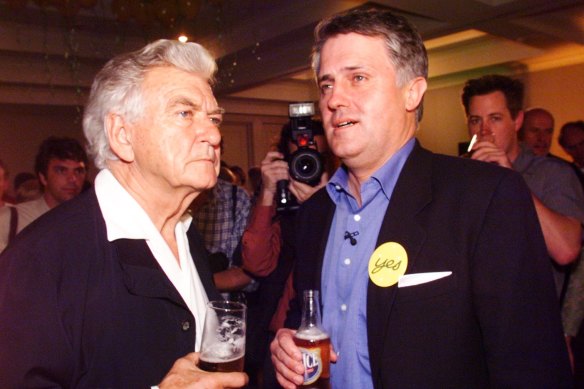This was published 6 months ago
Opinion
Voice lessons for republicans? Don’t give up on constitutional reform
Malcolm Turnbull
Former prime ministerSo, as the dust settles from the defeat of the Voice, republicans should not be disheartened. There are lessons to be learnt from the Voice, but they do not include giving up on constitutional reform.
It was so easy for the Voice to be represented as dividing Australia, as giving rights to some not available to all. Had the Voice been established first, voters would have at least known what they were voting for. As it happened, the Voice campaign presented a blank canvas on which its opponents could paint whatever apocalypse they liked.

King Charles, then Prince of Wales, with Malcolm Turnbull, then prime minister, in Canberra in 2015.Credit: Alex Ellinghausen
On the other hand, the cause of the republic is simply this; we are Australians, we believe every office under our Constitution should be open to any Australian citizen. Our head of state should be one of us not the king or queen of another country.
Our Constitution requires our members of parliament be citizens of Australia, and no other country. But it also requires our head of state to be whoever succeeds Queen Victoria in the sovereignty of the United Kingdom. Indeed, if the United Kingdom became a republic, its president would be our head of state!
The republic referendum was not lost in 1999 because of “too much detail” as some people have said as they endeavoured to justify the reckless decision to postpone the design of the Voice until after the referendum.
Referendums are always hard to win; compulsory voting means those “who don’t know” can’t just stay at home, they have to vote and are more likely to vote No. To win, you need overwhelming support and above all you need a Yes campaign that is united.
In 1999, we had the formidable advocacy of the prime minister John Howard and most of his government arrayed against us. But what really made the difference was the split between republicans.

How Australia voted in the 1999 republic referendum.Credit: The Age Archives
The model presented was designed to ensure the new head of state would have bipartisan support and so required the support of two thirds of a joint sitting of parliament and the nomination of both the prime minister and leader of the opposition.
Some republicans argued that the president should be directly elected and joined forces with the monarchists to urge a No vote. Whether from naivety or cynical calculation they argued that if we voted No in 1999 we would have another vote on a direct election model in a few years. That was a quarter of a century ago.
The No case in 1999 ran all the usual arguments, “if you don’t know, vote No” and conjured up fantastical risks attendant on cutting the umbilical cord with Buckingham Palace. But the most potent was the claim that it was “a politician’s republic” because the president would be appointed by parliament. One conservative politician after another proclaimed, “you can’t trust politicians”.
Peter Costello’s riposte was the pithiest: “Apparently you can trust politicians to set your taxes and go to war, but not to appoint the head of state.”
Nonetheless, the argument’s lack of merit did not detract from its impact.
To resolve this division, we need to bring the Australian people into the design process. There are only two viable modes of appointment – a parliamentary one more or less along the lines proposed in 1999 and direct election open to all, with the only restrictions (such as a large number of nominations) designed to ensure the number of candidates was manageable.
These should be fleshed out and presented to the Australian people in an advisory plebiscite with every effort made to ensure the highest possible participation rate.

Yes campaign leader Malcolm Turnbull with Bob Hawke on the night of the 1999 republic referendum.Credit: Dallas Kilponen
This will allow the mode of appointment issue to be debated in advance of the referendum. It is by no means certain that direct election will carry the day. In the lead up to the 1999 referendum we invariably found in focus groups, small and very large, that support for direct election quickly faded away when people realised a directly elected president would almost certainly be a politician. Or as Neville Wran once observed, “if they aren’t a politician when they nominate, they certainly will be by the time they win”.
The plebiscite will settle the matter, everyone will have had their say; attention will then turn to incorporating the agreed mode of election into the necessary amendments and presenting them in a formal constitutional referendum in which the focus of the Yes campaign will be on the uplifting, unifying, patriotic message of an Australian head of state rather than arguing about the minutiae of different modes of appointment.
The opponents of change will, of course, seek to frustrate this process at every turn. But in my experience Australians like to have their say, to be consulted, and they will welcome the opportunity to participate in the plebiscite on the model. There were furious opponents of the same-sex marriage plebiscite too, yet 80 per cent of Australians participated. That’s only about 10 per cent less than participate in a parliamentary election, where voting is compulsory.
Malcolm Turnbull was prime minister of Australia from 2015-2018. He was chair of the Australian Republican Movement between 1993 and 2000.
The Opinion newsletter is a weekly wrap of views that will challenge, champion and inform your own. Sign up here.